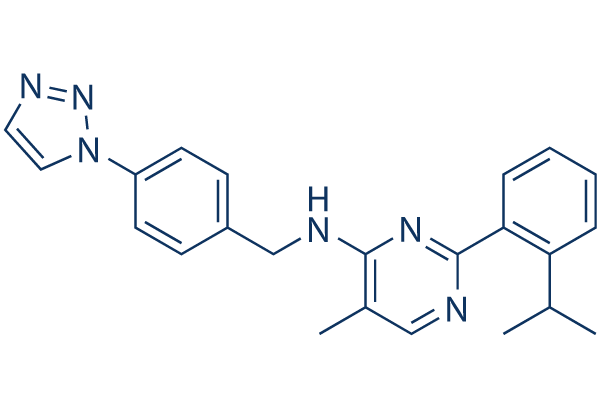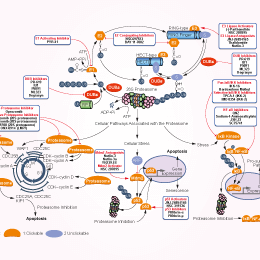
- Bioactive Compounds
- By Signaling Pathways
- PI3K/Akt/mTOR
- Epigenetics
- Methylation
- Immunology & Inflammation
- Protein Tyrosine Kinase
- Angiogenesis
- Apoptosis
- Autophagy
- ER stress & UPR
- JAK/STAT
- MAPK
- Cytoskeletal Signaling
- Cell Cycle
- TGF-beta/Smad
- DNA Damage/DNA Repair
- Compound Libraries
- Popular Compound Libraries
- Customize Library
- Clinical and FDA-approved Related
- Bioactive Compound Libraries
- Inhibitor Related
- Natural Product Related
- Metabolism Related
- Cell Death Related
- By Signaling Pathway
- By Disease
- Anti-infection and Antiviral Related
- Neuronal and Immunology Related
- Fragment and Covalent Related
- FDA-approved Drug Library
- FDA-approved & Passed Phase I Drug Library
- Preclinical/Clinical Compound Library
- Bioactive Compound Library-I
- Bioactive Compound Library-Ⅱ
- Kinase Inhibitor Library
- Express-Pick Library
- Natural Product Library
- Human Endogenous Metabolite Compound Library
- Alkaloid Compound LibraryNew
- Angiogenesis Related compound Library
- Anti-Aging Compound Library
- Anti-alzheimer Disease Compound Library
- Antibiotics compound Library
- Anti-cancer Compound Library
- Anti-cancer Compound Library-Ⅱ
- Anti-cancer Metabolism Compound Library
- Anti-Cardiovascular Disease Compound Library
- Anti-diabetic Compound Library
- Anti-infection Compound Library
- Antioxidant Compound Library
- Anti-parasitic Compound Library
- Antiviral Compound Library
- Apoptosis Compound Library
- Autophagy Compound Library
- Calcium Channel Blocker LibraryNew
- Cambridge Cancer Compound Library
- Carbohydrate Metabolism Compound LibraryNew
- Cell Cycle compound library
- CNS-Penetrant Compound Library
- Covalent Inhibitor Library
- Cytokine Inhibitor LibraryNew
- Cytoskeletal Signaling Pathway Compound Library
- DNA Damage/DNA Repair compound Library
- Drug-like Compound Library
- Endoplasmic Reticulum Stress Compound Library
- Epigenetics Compound Library
- Exosome Secretion Related Compound LibraryNew
- FDA-approved Anticancer Drug LibraryNew
- Ferroptosis Compound Library
- Flavonoid Compound Library
- Fragment Library
- Glutamine Metabolism Compound Library
- Glycolysis Compound Library
- GPCR Compound Library
- Gut Microbial Metabolite Library
- HIF-1 Signaling Pathway Compound Library
- Highly Selective Inhibitor Library
- Histone modification compound library
- HTS Library for Drug Discovery
- Human Hormone Related Compound LibraryNew
- Human Transcription Factor Compound LibraryNew
- Immunology/Inflammation Compound Library
- Inhibitor Library
- Ion Channel Ligand Library
- JAK/STAT compound library
- Lipid Metabolism Compound LibraryNew
- Macrocyclic Compound Library
- MAPK Inhibitor Library
- Medicine Food Homology Compound Library
- Metabolism Compound Library
- Methylation Compound Library
- Mouse Metabolite Compound LibraryNew
- Natural Organic Compound Library
- Neuronal Signaling Compound Library
- NF-κB Signaling Compound Library
- Nucleoside Analogue Library
- Obesity Compound Library
- Oxidative Stress Compound LibraryNew
- Plant Extract Library
- Phenotypic Screening Library
- PI3K/Akt Inhibitor Library
- Protease Inhibitor Library
- Protein-protein Interaction Inhibitor Library
- Pyroptosis Compound Library
- Small Molecule Immuno-Oncology Compound Library
- Mitochondria-Targeted Compound LibraryNew
- Stem Cell Differentiation Compound LibraryNew
- Stem Cell Signaling Compound Library
- Natural Phenol Compound LibraryNew
- Natural Terpenoid Compound LibraryNew
- TGF-beta/Smad compound library
- Traditional Chinese Medicine Library
- Tyrosine Kinase Inhibitor Library
- Ubiquitination Compound Library
-
Cherry Picking
You can personalize your library with chemicals from within Selleck's inventory. Build the right library for your research endeavors by choosing from compounds in all of our available libraries.
Please contact us at info@selleckchem.com to customize your library.
You could select:
- Antibodies
- Bioreagents
- qPCR
- 2x SYBR Green qPCR Master Mix
- 2x SYBR Green qPCR Master Mix(Low ROX)
- 2x SYBR Green qPCR Master Mix(High ROX)
- Protein Assay
- Protein A/G Magnetic Beads for IP
- Anti-Flag magnetic beads
- Anti-Flag Affinity Gel
- Anti-Myc magnetic beads
- Anti-HA magnetic beads
- Poly DYKDDDDK Tag Peptide lyophilized powder
- Protease Inhibitor Cocktail
- Protease Inhibitor Cocktail (EDTA-Free, 100X in DMSO)
- Phosphatase Inhibitor Cocktail (2 Tubes, 100X)
- Cell Biology
- Cell Counting Kit-8 (CCK-8)
- Animal Experiment
- Mouse Direct PCR Kit (For Genotyping)
- New Products
- Contact Us
research use only
ML323
DUB inhibitor
ML323 displays reversible, nanomolar inhibitory activity and excellent selectivity toward USP1/UAF1 with IC50 of 76 nM.

Chemical Structure
Molecular Weight: 384.48
Purity & Quality Control
Batch:
Purity:
99.99%
99.99
Related Products
| Related Targets | USP/UBP UCH | Click to Expand |
|---|---|---|
| Related Products | PR-619 P5091 P22077 IU1 b-AP15 LDN-57444 VLX1570 EOAI3402143 PLpro inhibitor USP25/28 inhibitor AZ1 TCID ML364 SJB2-043 GSK2643943A | Click to Expand |
| Related Compound Libraries | Kinase Inhibitor Library FDA-approved Drug Library Natural Product Library Bioactive Compound Library-I Highly Selective Inhibitor Library | Click to Expand |
Signaling Pathway
Mechanism of Action
| Features | USP1-UAF1-selective inhibitor. | ||
|---|---|---|---|
| Targets |
|
In vitro |
||||
| In vitro | ML323 inhibits the deubiquitination of PCNA and FANCD2 by inhibiting USP1–UAF1 activity in H596 cells. Moreover, ML323 potentiates cytotoxicity in NSCLC H596 cells and U2OS osteosarcoma cells by targeting two major DNA damage response pathways (TLS and FA). [1] |
|||
|---|---|---|---|---|
| Kinase Assay | High-throughput screening | |||
| For HTS, USP1-UAF1 activity is monitored using ubiquitin-rhodamine 110 as a substrate. The assay is miniaturized to a 4 μL volume in a 1,536-well format and is used to screen approximately 402,701 compounds in quantitative HTS mode, with each compound tested over a range of four to five concentrations. The assay shows robust performance with an average Z’factor of 0.8 throughout the screen. | ||||
| Cell Research | Cell lines | H596 cells | ||
| Concentrations | ~30 μM | |||
| Incubation Time | 7-12 days | |||
| Method | For the colony-forming assay, cells are seeded at a density of 300–500 cells per well in six-well plates and grown overnight. Cells are then treated with ML323 alone at the indicated concentrations. Cells treated with an equal volume of DMSO and saline are used as control. After 48 h of treatment, fresh growth medium is added, and cells are incubated for an additional 5-10 d to allow for colony formation. For UV combination treatment, the cells are treated with ML323 at the indicated concentrations or an equal volume of DMSO. After 48 h, the medium is removed, and cells are irradiated at 254 nm at the indicated dosage. Fresh growth medium is added, and the cells are incubated for an additional 5-10 d to allow for colony formation. The cells without UV irradiation but treated with ML323 or an equal volume of DMSO are used as controls and designated as 100%. After the formation of the colonies, cells are fixed with methanol and stained with 0.5% crystal violet. Colonies consisting of >50 cells are scored. The number of colonies is determined from triplicate plates. The dose-response curves are generated using GraphPad Prism and analyzed by using CalcuSyn to calculate the combination index. |
|||
In Vivo |
||
| In vivo | ML323 is a selective USP1–UAF1 inhibitor that inhibit deubiquitinase activity of USP1–UAF1 complex. |
|
|---|---|---|
| Animal Research | Animal Models | Female C57BL/6J mice |
| Dosages | 10 mg/kg | |
| Administration | i.p. | |
References |
|
Chemical Information
| Molecular Weight | 384.48 | Formula | C23H24N6 |
| CAS No. | 1572414-83-5 | SDF | Download SDF |
| Synonyms | N/A | ||
| Smiles | CC1=CN=C(N=C1NCC2=CC=C(C=C2)N3C=CN=N3)C4=CC=CC=C4C(C)C | ||
Storage and Stability
| Storage (From the date of receipt) | |||
|
In vitro |
DMSO : 76 mg/mL ( (197.66 mM) Moisture-absorbing DMSO reduces solubility. Please use fresh DMSO.) Ethanol : 38 mg/mL Water : Insoluble |
Molecular Weight Calculator |
|
In vivo Add solvents to the product individually and in order. |
In vivo Formulation Calculator |
|||||
Preparing Stock Solutions
Molarity Calculator
In vivo Formulation Calculator (Clear solution)
Step 1: Enter information below (Recommended: An additional animal making an allowance for loss during the experiment)
mg/kg
g
μL
Step 2: Enter the in vivo formulation (This is only the calculator, not formulation. Please contact us first if there is no in vivo formulation at the solubility Section.)
% DMSO
%
% Tween 80
% ddH2O
%DMSO
%
Calculation results:
Working concentration: mg/ml;
Method for preparing DMSO master liquid: mg drug pre-dissolved in μL DMSO ( Master liquid concentration mg/mL, Please contact us first if the concentration exceeds the DMSO solubility of the batch of drug. )
Method for preparing in vivo formulation: Take μL DMSO master liquid, next addμL PEG300, mix and clarify, next addμL Tween 80, mix and clarify, next add μL ddH2O, mix and clarify.
Method for preparing in vivo formulation: Take μL DMSO master liquid, next add μL Corn oil, mix and clarify.
Note: 1. Please make sure the liquid is clear before adding the next solvent.
2. Be sure to add the solvent(s) in order. You must ensure that the solution obtained, in the previous addition, is a clear solution before proceeding to add the next solvent. Physical methods such
as vortex, ultrasound or hot water bath can be used to aid dissolving.
Tech Support
Answers to questions you may have can be found in the inhibitor handling instructions. Topics include how to prepare stock solutions, how to store inhibitors, and issues that need special attention for cell-based assays and animal experiments.
Tel: +1-832-582-8158 Ext:3
If you have any other enquiries, please leave a message.
* Indicates a Required Field






































